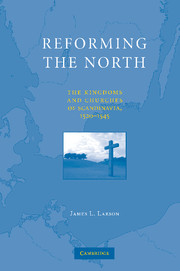Book contents
- Frontmatter
- Contents
- Acknowledgments
- Abbreviations
- Maps
- REFORMING THE NORTH
- Introduction
- 1 The North
- Part I Lord of the Northern World, 1513–1523
- 2 Preliminary
- 3 Christian II's Other Kingdom
- 4 A Conquest
- 5 Hubris
- 6 Insurrection
- 7 The King's Fall
- Part II Successors, 1523–1533
- Part III Civil War, 1533–1536
- Part IV The Settlement, 1536–1545
- 21 Conclusion
- Bibliography
- Index
3 - Christian II's Other Kingdom
Published online by Cambridge University Press: 26 February 2010
- Frontmatter
- Contents
- Acknowledgments
- Abbreviations
- Maps
- REFORMING THE NORTH
- Introduction
- 1 The North
- Part I Lord of the Northern World, 1513–1523
- 2 Preliminary
- 3 Christian II's Other Kingdom
- 4 A Conquest
- 5 Hubris
- 6 Insurrection
- 7 The King's Fall
- Part II Successors, 1523–1533
- Part III Civil War, 1533–1536
- Part IV The Settlement, 1536–1545
- 21 Conclusion
- Bibliography
- Index
Summary
At the time of King Hans's death, the kingdom of Norway was already under Duke Christian's control. As regent the duke had ended attempts to conspire with the Swedes and placed dependable men at the great fortresses; his chancellor, Erik Valkendorf, had received the Trondheim archdiocese, and led the Norwegian council. The council had neither the will nor the ability to oppose Christian, and those Norwegians who took part in his election largely followed the lead of the Danish council. Christian was so confident of his control in Norway that after his coronation in Oslo in 1514, he did not visit the kingdom again during his reign.
The early years were relatively quiet. As in Denmark, events picked up speed around 1517. The king granted power to new men, commoners without roots in the kingdom, wholly dependent on the king and his authority. Sigbrit's favorites took control of the great fiefs; cooperative clerics received important prelatures in Oslo and Bergen. The tendency toward absolute rule was soon obvious, and followed a far more consistent line than in Denmark. The council of the realm no longer participated in administration. The crown levied taxes and issued decrees without consultation. After 1516 the council no longer functioned as the kingdom's supreme court. Since there was no other institution capable of handling protests and appeals, the king's men reorganized administration and the legal system as they saw fit.
- Type
- Chapter
- Information
- Reforming the NorthThe Kingdoms and Churches of Scandinavia, 1520–1545, pp. 52 - 64Publisher: Cambridge University PressPrint publication year: 2010



